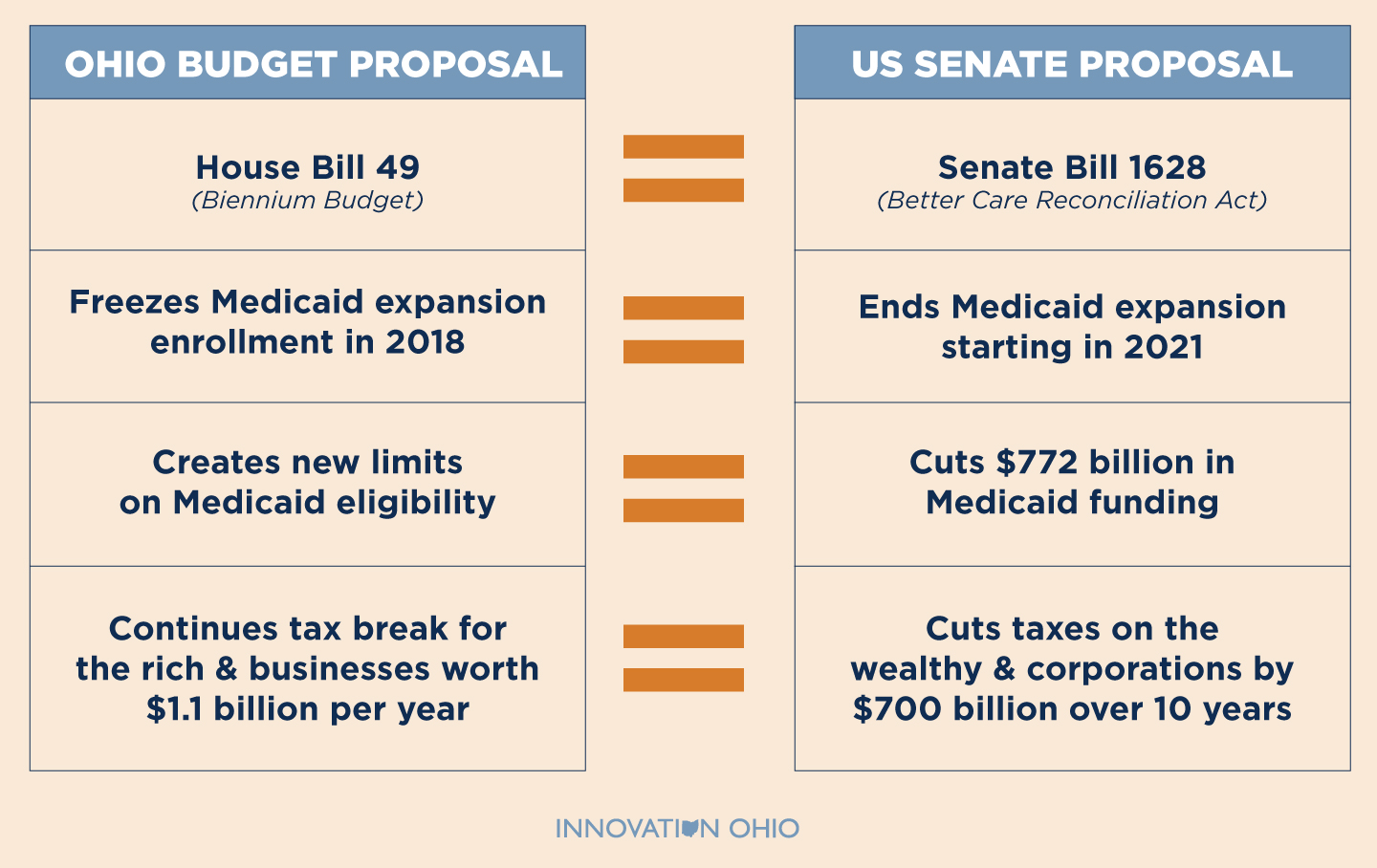What you need to know about Ohio Politics and Policy
Terra Goodnight · June 27, 2017
Medicaid cuts and tax breaks? Ohio budget mirrors Congressional effort.
*this post has been edited to reflect last night’s vote in conference committee. In an eerie parallel to what we are seeing in our nation’s capital, Ohio Republicans are preparing to enact a sweeping proposal that would cut healthcare for the state’s neediest in order to finance a tax cut for the rich and well-connected. Last night, a Republican-controlled committee made up of lawmakers from Ohio’s House and Senate released the final version of a two-year state budget that in many ways looks remarkably similar to the Congressional healthcare proposal. But the Ohio plan could be equally devastating.Compare:
 There are three main components of the budget plan that will impact access to healthcare for Ohio’s Medicaid expansion population (low income adults with incomes below 138 percent of federal poverty):
There are three main components of the budget plan that will impact access to healthcare for Ohio’s Medicaid expansion population (low income adults with incomes below 138 percent of federal poverty):
- Freeze on expansion (low-income adult) enrollment
- New eligibility limits
- Premiums for low-income recipients
 The House added language limiting access to Medicaid expansion (currently available to all adults with incomes below 138 percent of poverty) to those age 55 or over, as well as young individuals employed or enrolled in school, training, or addiction treatment, or who have “intensive” healthcare needs that make working impractical. In effect, the proposal would block coverage to the newly unemployed, anyone looking for work and people on a waiting list for addiction treatment.
Governor Kasich included a new $20 monthly premium for Medicaid recipients in the expansion category. However, many experts have noted that for people at very low incomes, even a modest premium can become a barrier to care. Providers who work with patients suffering with mental health and addiction problems have suggested that their health challenges make compliance with monthly payment requirements difficult to achieve. Fully 15 percent of the expansion population — over 100,000 Ohioans — could lose coverage as a result.
Every iteration of the state budget has included cuts or limits on the growth of Medicaid spending, most recently a $200 million cut that the Senate included to close an anticipated $1 billion revenue hole. These cuts and reductions in eligibility come in a budget which preserves an unproven $1.1 billion tax break that allows lawyers, lobbyists and even many lawmakers to shield a quarter of a million dollars in income each year from taxation. Closing this one tax loophole would eliminate the need for Medicaid and other cuts in the budget.
As the US Senate regroups to advance its plan to reduce taxes on the rich, paid for with cuts to healthcare coverage for poor and working Americans, we cannot lose sight of efforts by lawmakers closer to home that have the same effect.
The House added language limiting access to Medicaid expansion (currently available to all adults with incomes below 138 percent of poverty) to those age 55 or over, as well as young individuals employed or enrolled in school, training, or addiction treatment, or who have “intensive” healthcare needs that make working impractical. In effect, the proposal would block coverage to the newly unemployed, anyone looking for work and people on a waiting list for addiction treatment.
Governor Kasich included a new $20 monthly premium for Medicaid recipients in the expansion category. However, many experts have noted that for people at very low incomes, even a modest premium can become a barrier to care. Providers who work with patients suffering with mental health and addiction problems have suggested that their health challenges make compliance with monthly payment requirements difficult to achieve. Fully 15 percent of the expansion population — over 100,000 Ohioans — could lose coverage as a result.
Every iteration of the state budget has included cuts or limits on the growth of Medicaid spending, most recently a $200 million cut that the Senate included to close an anticipated $1 billion revenue hole. These cuts and reductions in eligibility come in a budget which preserves an unproven $1.1 billion tax break that allows lawyers, lobbyists and even many lawmakers to shield a quarter of a million dollars in income each year from taxation. Closing this one tax loophole would eliminate the need for Medicaid and other cuts in the budget.
As the US Senate regroups to advance its plan to reduce taxes on the rich, paid for with cuts to healthcare coverage for poor and working Americans, we cannot lose sight of efforts by lawmakers closer to home that have the same effect.
 Today: Call your Ohio Representative and Senator and ask them to vote no on a budget that protects a tax break for the rich, but not Medicaid recipients.
Today: Call your Ohio Representative and Senator and ask them to vote no on a budget that protects a tax break for the rich, but not Medicaid recipients.
Tagged in these Policy Areas: Ohio State Budget


